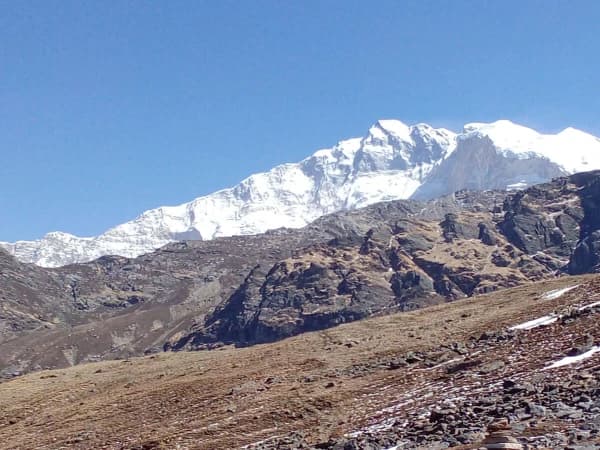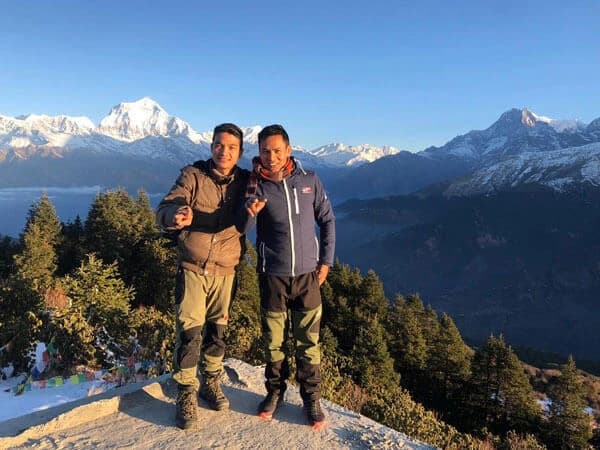The Annapurna Region of the Nepalese Himalayas has become one of the best trekking regions in the world due to its beautiful landscape, cultural diversity, and high accessibility. The region is about 80 kilometers long, stretching from the Marsyangdi River in the east to the Kali Gandaki River in the west, giving it a manageable scale.
Annapurna I (8,091m), the tenth-highest mountain in the world, certainly represents the flagship of Annapurna region and that of a number of other high-elevation mountains, such as Annapurna II, Annapurna III, the most iconic mountain in the world - Machhapuchhre, etc.
The Annapurna conservation area is the largest protected area in Nepal (7,629 square km); it is home to seldom-seen animals, countless plant species, and lively communities of Indigenous people.
The Annapurna region has its own unique climate and environment features trekkers will encounter that include lush subtropical forests, terraced fields, high-altitude deserts, and traditional villages with Gurung, Magar, Thakali, and Manangba communities, each with their own customs and festivals.
While trekking in this area, you will also see amazing features of nature, like the deepest gorge in the world (Kali Gandaki) and the beautiful turquoise Tilicho Lake.
Another area of interest in this region, Pokhara, is a lovely lake town at 828 meters elevation, is located at the south end of the Annapurna region, and is the launching point for many treks in the Annapurna area.
Some popular treks/routes include: the classic Annapurna circuit, trekking to Annapurna Base Camp (ABC), the Ghorepani Poon Hill trek, and trek into Magical Mustang and Nar-Phu valleys.
This area is accessible to trekkers regardless of experience (using the tea house trekking system) as it has developed hiking/trails, comfortable tea houses/lodges, a temperate climate, some of the most stunning views of the Himalaya, and ample opportunity to experience the local culture at a slow pace.
What Makes the Annapurna Region Unique?
- World's Deepest River Gorge: Within the Annapurna and Dhaulagiri range lies Kali Gandaki Gorges, which is considered the world's deepest river gorge, 3 miles long and 1.5 miles wide!
- World's Highest Freshwater Lake: Just north of Annapurna massif in the Manang district is Tilicho Lake, the world's highest freshwater lake, which includes the region's natural landmark.
- Greatest elevation mix of biodiversity and striking mountain peaks: The Annapurna massif also has some of the highest elevations in the world (8,091m) with Annapurna I, Annapurna II, Dhaulagiri (8167m), and Machhapuchhre, the fish-tail mountain, and many, many other massive peaks that provide some incredible views.
- World's Largest Biodiversity Preservation Area: The largest preserved area in Nepal is the Annapurna Conservation Area at 7,629 sq. km, including over 474 bird species, 102 mammal species, including endangered species, e.g., snow leopards, blue sheep, red pandas, and so many reptiles and amphibians
- Cultural Diversity and Abundant Hospitality: The cultural diversity of some ethnic Indigenous people comes from groups such as Gurung, Manangi, Thakali, Magar, and others who are rich in culture and hospitality.
- Trekking provides the opportunity for trekkers to enjoy a mix of Hindu and Buddhist cultures while walking through towns and villages. Trekking also allows you to visit sacred things, like one of the most sacred things in the Himalayan Region, or trekking to ancient monasteries.
- Varied Trekking Routes: Annapurna has the most trekking routes in Nepal, with some of them being as simple as a day hike and others multi-week expeditions, such as Annapurna Circuit, Annapurna Base Camp, Upper Mustang, giving room for adventurers of all types.
- Accessible without losing the Adventure: With a well-established trail system, teahouses, and lodges, trekking in Annapurna provides the perfect balance between the accessible and the adventurous. This is why the Annapurna region is one of the most popular trekking destinations in the world.
Annapurna Region Location and Facts
Location of the Annapurna Region
The Annapurna Region is located in north-central Nepal, and lies within Gandaki Province. It is northwest of the Pokhara Valley and approximately 55 km long. The massif has geographical boundaries on the west side with the Kali Gandaki Gorge, on the north and east with the Marsyangdi River, and on the south with Pokhara Valley.
Mount Annapurna, the highest peak within the Annapurna massif, has a general location of 28°35′46″N latitude and a longitude of 83°49′13″E (Wikipedia: Annapurna) Annapurna I, the highest peak of the massif is 8,091 meters (26,545 ft) ranks ten in the world in height.
Key Facts About the Annapurna Region
- The Annapurna range consists of thirteen peaks above 7000 meters and sixteen more above 6000 meters.
- Annapurna I, Annapurna II, III, and IV and the famous Machhapuchhre or Fish Tail Mountain.
- Annapurna is also known for difficult climbs and trekking routes like the Annapurna Circuit and Annapurna Base Camp, which will continue to entice people from all parts of the globe to come to search out.
Annapurna Conservation Area
With an area of 7,629 square kilometers, the Annapurna Conservation Area is Nepal's largest protected area. It was established in 1992, and protect areas in several districts, including Manang, Mustang, Kaski, Myagdi and Lamjung. The Annapurna Conservation Area protects a number of ecosystems in Nepal, starting with lowland subtropical forests in south and east Nepal to the alpine deserts to the north, near Mustang and Tibet. It has the conservation goals of protecting biological diversity and heritage and is supporting biodiversity engagement and sustainable trekking and tourism.
Climate and Terrain
This area has two very distinctive climatic zones due to the large elevation difference from about 790 meters to above 8000 meters and the life zones range from the monsoon rains on the southern, sloping side of the terrain to the rain shadow areas of the northern slopes where there is very little moisture.
Above 2,000 meters there are frequent snow falls and winter temperatures can dip below freezing at the higher elevations. The diverse climatic zones add climate person diversity, and contribute to the diverse landscapes like the lush valleys and more jagged, high altitude landscapes.
Popular Trekking Packages in the Annapurna Region for Beginner to Experience Trekkers
Ghorepani Poon Hill Trekking - 7 Days
Starting from US$590
Since this trek is relatively new, I can easily recommend the Ghorepani Poon Hill Trek for first-time trekkers or those looking for a trek that is both shorter and with significance in the Himalayas.
The trek itself is a classic seven-day trek with stunning views of the Annapurna and Dhaulagiri ranges from Poon Hill at 3,210 meters (10,531 feet).
Ghorepani Poon Hill trekking takes trekkers through Gurung and Magar villages; charming rhododendron forests, and terraced fields work perfectly to provide treks with mixed culture along with natural experiences.
The trekking experience is a moderate/easy trek experience, which is reasonable walking hours on a daily basis, which means that anyone who wants to experience trekking in Nepal can experience it as a beginner or as a family.
The altitude of the trek is also relatively low compared to other trek routes, whereby the risk or effect of high altitude sickness is less. Finally, the sunrise view from Poon Hill will be a cherished moment for all visitors.
Annapurna Base Camp Trekking - 10 Days
Starting from From US$700
The Annapurna Base Camp (ABC) Trek is a classic, moderate trek that can take around 10 days as it takes you to the base of Annapurna I at 4,130 meters, one of the highest peaks in the world. The trails consist of stone steps, forest trails, and alpine landscapes that trekkers will enjoy.
Trekkers will encounter aspects of the local cultures in colorful and vibrant villages like Chhomrong and Jhinu Danda. You will need to adapt to the altitude, but the teahouses are established well along the trail, and the progression to base camp is gradual, which makes this trek, in the right situation and preparation, very doable.
Annapurna Circuit Trekking - 12 Days
Starting from From US$800
The Annapurna Circuit trek takes 12 days to complete, is the longest and most challenging trek in the region, and is considered a trek for intermediate to advanced trekkers. The trek presents a variety of landscapes, including subtropical forests, valleys, and high-altitude desert landscapes as it circles around the Annapurna massif, with the main highlight being the crossing of the Thorong La pass at an omnium of 5,416 meters.
This trek will require a good amount of fitness and appropriate acclimatization. Trekkers taking this trek will cross some Tibetan cultural villages, wearing traditional Tibetan clothing, and will meet a variety of ethnic groups throughout the route. The distance and the fluctuation of altitudes allow trekkers the most holistic experience of the Himalayas, which is another reason this trek is considered one of the most popular treks in Nepal.
Nar Phu Valley Trekking - 16 Days
Starting from From US$1299
The Nar Phu Valley Trek is an adventurous, secluded trek suited for trekkers who are seeking a unique eastern approach for a 16-day trek located north of the Annapurna Circuit. This trek travels through untouched, pristine wilderness, ancient-Tibetan-influenced villages, over high mountain passes, and heights beyond 5,000 meters, which require decent acclimatization and good fitness because of the strenuousness of the trek (and possible altitude sickness).
Because of the eerie remoteness of the trek, a trekker is immersed in untouched Himalayan culture, surrounded by few tourists and little to no infrastructure. This trekking route is indicative of what the Himalayas has to offer in untouched nature, culture, adventure, and diversity in trekking terrain, leaving you wanting to explore more rugged, obscure, and awesome treasures in the Himalayas.
Khopra Ridge Trekking - 10 Days
Starting from From US$700
Khopra Ridge Trek is a moderate 10-day trek that will provide you with jaw-dropping views of the beautiful Annapurna Mountain Range and Dhaulagiri Ranges from the Khopra Ridge viewpoint. This trek has cultural elements of the Gurung villages as well as dense and still rhododendron forests and grassy alpine meadows, which will all impress and stand out differently as you work around the area. Compared to the Poon Hill trek, the Khopra Ridge trek gets fewer trekkers.
However, you will get just as epic of views on this trek and the chance to sight a few wildlife in the process. This hike's climb to Khopra Danda, at approx 3700 m (12140 ft), is a gradual one that is equipped and accessible to intermediate trekkers who want some culture with their thrills of trekking and getting lost in nature and beauty.
Dhaulagiri Circuit Trekking - 17 Days
Starting from From US $1986
The Dhaulagiri Circuit Trek is a strenuous high-altitude trek that exceeds 5,000 meters before crossing the French Pass at 5,360 m. The trek takes 17 days and is suited for advanced trekkers looking for an extended adventure that is strenuous and remote in the Himalayas. The trek circumnavigates the entire Dhaulagiri massif while making use of rough terrain, glacial moraine, and remote villages that also offer spectacular mountain vistas and are alone.
This trek will test the strength of even a fit hiker, and hiking at altitude and technical difficulties will pose a challenge. Your success will depend on your overall physical fitness, acclimatization, and prior trekking experience. This trek will appeal to trekkers who are seeking a less busy trail along with spectacular views of the landscape along with cultural encounters and experiences.
Who Lives in the Annapurna Region and What Cultures Thrive?
Gurung
The Gurung are one of the largest ethnic groups in the Annapurna region. They inhabit mostly mid-hill villages, for example, Ghandruk, Ghorepani, and Sikles. Traditionally, the Gurung relied on farming and herding and have a reputation for bravery as well as the many Gurung people who have served in the British Gurkha regiments.
- Festivals: The Gurung people celebrate Tamu Lhosar (Gurung New Year), Dashain & Tihar, and Buddha Jayanti. They also perform various songs and dances, Ghatu and Sorathi, during festivals and specific rituals.
- Language, Religion, and Way of Life: The Gurung speak Tamu Kyi, and adhere to a religion blending aspects of Buddhism, Hinduism, and Shamanism. Houses are made of stone and built into terraced hillsides. The Gurung hospitality is among the most generous for trekkers.
Magar
The Magars are also yet another indigenous hill tribe that can be seen spread out between the Myagdi district and Lamjung district in the Annapurna region. They have also historically been known as warriors and farmers and have been a part of the military history of Nepal.
- Festivals: The Magar celebrate Maghe Sankranti, Tihar, and their own Magar New Year. The dance, music, and display of colorful festivities are highly regarded events during many of their feasts.
- Language, Religions and Livelihood: The Magar not only have their original language ( Magar language) but also a conglomeration of Animism, Buddhism, and Hinduism beliefs. The Magar are primarily agriculturalists and have livestock like buffalos. The Magar's are noted to display community connectivity and courage.
Thakali
In the lower Mustang and Kali Gandaki Valley, the Thakalis are a well-known and extremely important ethnic group who have traditionally traded salt and cereals along the Tibetan route. The Thakalis are recognized for their clean villages and delicious cuisine.
- Festivals Held: The Thakalis hold a number of festivals: Lha Phewa (held one time in 12 years), Yartung, and Losar, all of which have celebrations with rituals, dances, and horse races.
- Language, Religion, and Culture: The Thakalis speak the Thakali language. They are Buddhists, but their belief system has Bon influences as well. The Thakalis are a brilliant ethnic group and are known for their business sense and hygiene. The Thakali food is famous worldwide, and is enjoyed all across Nepal as well.
Manangi (Nyeshang):
The Manangi people live in Upper Manang, a really high mountainous area very near the Tibetan border. The Manangi have had many Tibetan influences as they have developed over many centuries; the Manangi way of life consists of yak herding, trade, and now trekking tourism.
- Festivals Celebrated: Key festivals celebrated are Yartung, Losar, and Mani Rimdu. All these festivals involve dancing, masked plays, and, of course, some Buddhist rituals. Festivals are characterized by lots of good food and spirits!
- Language, Religion, and Lifestyle: The Manangi speak a dialect called Nyeshangba, derived from Tibetan. The Manangi follow Tibetan Buddhism. Their way of life consists of monasteries, stone villages, and a very high mountain way of making a living.
Tibetan Refugees
In the 1950s, Tibetan refugees fled from Tibet to Mustang and other isolated pockets of settlement around Pokhara, where they could preserve their spiritual and cultural identity through monasteries and traditional activities.
- Holidays/celebrations: They celebrate holidays including Losar, Saga Dawa, and Monlam, typically with a prayer ceremony, butter lamps, and, when they have the opportunity to, gather together.
- Language, religion, and lifestyle: Tibetan, along with Tibetan Buddhism, is the primary language and religion spoken and practiced by Tibetans. Most of the participants are engaged in making carpets and handicrafts, providing cultural education to Tibetans. Their existence offers a very strong spiritual presence in the area.
Hindu Communities (Brahmin, Chhetri)
They are typically located in low-lying elevations and in valleys in and around Annapurna. The inhabitants are from major Hindu caste groups of Nepal and tend to work in agriculture, administration, or tourism.
- The festivals they celebrate: They celebrate all major Hindu festivals in Nepal, including Dashain, Tihar, Holi, Teej, and Janai Purnima, with rituals, fasting, and sharing of food.
- Language, Religion, and Culture: They speak Nepali, are Hindu, and live in terraced farming settlements. Dalit groups have been marginalized historically but are now growing in their roles in local culture and crafts.
Tamang
The Tamang, a Tibeto-Burman ethnic group, have small communities often dispersed around the Annapurna region. The Tamang are a music-loving cultural group with Buddhist practices.
- Festivals: The Tamang celebrate Sonam Lhosar, Buddha Jayanti, and Maghe Purne. Tamang has many festivals that include dancing and music with Tamang Selo.
- Language, Religion, and Lifestyle: The Tamang speak the Tamang language and practice a version of the Buddhist Tibetan religion, which is usually practiced with Lamas. The Tamang live in close neighboring communities, dressed in bright clothes, and get the forthcoming holidays, telling stories in great abundance.
Famous and Magnificent Mountains Located in the Annapurna Region
There are many beautiful and famous Himalayan mountains in the Annapurna region. The most famous mountain, and arguably the most difficult climb, is Annapurna I (8,091m) which is the 10th tallest mountain in the world, as well as Annapurna South (7,219m) and Annapurna III (7,555m) which are also in the area.
There is also Machapuchare (Fishtail) (6993m), which is exceptionally beautiful in that it actually looks like a fishtail. It is considered sacred, and it is a unique mountain, so no climber can attempt to summit.
On the Annapurna circuit, many of the more well-known mountains that will be seen are Dhaulagiri (8,167m) there are some locations on the Annapurna circuit where you can see Dhaulagiri, and Gangapurna (7,455m) can be seen from the Annapurna base camp trek.
Besides those mountains, there were also Hiunchuli (6,441m) and Nilgiri (7,061m); it was great to see such a unique and beautiful variety of mountains on many different routes.
Trek Routes to See These Mountains:
- Annapurna Circuit Trek: Provides outstanding views of Annapurna I, Dhaulagiri, Machapuchare, and Nilgiri.
- Annapurna Base Camp (ABC) Trek: Located underneath the buffer zone of Annapurna I, Annapurna South, Gangapurna, and Machapuchare.
- Ghorepani Poon Hill Trek: known for its early morning sunrise views over the ranges of Annapurna and Dhaulagiri.
- Mardi Himal trek: Shows outstanding views of Machapuchare and Annapurna South.
How Difficult are Annapurna Region Treks?
Annapurna treks can be classified from moderate to difficult in terms of difficulty. An average hiker with basic to normal fitness should feel comfortable to hike an Annapurna trek.
Some treks, such as the Ghorepani Poon Hill Trek, tend to be relatively easier in terms of trek difficulty and for families; conversely, other treks expect a good fitness level and time acclimating to the altitude and time spent hiking every day.
Hike time
Hikes on an Annapurna trek typically will be 4- 8 hours a day, depending upon the trek and your pace. The high elevation may mean you need to hike at a slower pace and for shorter hours each day to help avoid altitude sickness.
Starting location
Most Annapurna treks start in the adventure hub of Pokhara, Nepal, accessible by road or a short internal flight.
Length of circuit
The Annapurna Circuit Trek is about 160-230 km in distance, while the shorter treks, such as Poon Hill, are about 40 km return trip.
Hiking guide
For safety, to appreciate the culture, and to learn the navigation of the Annapurna region, we recommend you secure a local guide. Securing a guide is especially important if it is a long trek or if the trek is not well marked.
Best Time to Trek in the Annapurna Region
The best seasons to visit the Annapurna Region are normally spring (March-May) and autumn (September - November).
These seasons can normally be counted on to provide great weather, mild temperatures, clear skies, and good trekking conditions that blend well to allow the visitor to appreciate both the beautiful scenery and cultural elements of the region.
Why Spring (March–May)?
- Comfortable and mild temperatures - ideal for hiking.
- The landscape is often full of rhododendrons and pretty wildflowers in full bloom.
- Many days will have clear skies and nice mountain views.
- Much longer trekking hours, thanks to longer hours of daylight.
- It will likely have fewer visitors than autumn and be more "laid back".
What Makes Autumn (September–November) Ideal?
- The cool air after the monsoon clears out moisture, dust, and pollution from the air.
- A uniform weather pattern of abundant blue skies and modest temperatures.
- The very best trekking season, with busy tea houses and lots of local festivals.
- Easier viewing and visibility of the amazing Annapurna and Dhaulagiri mountains.
- Ideal timing for photos and cultural experience.
Can You Trek in Winter or Monsoon?
Trekking is possible in the winter and monsoon, but conditions are worse.
Winter (December-February):
- Cold temperatures (especially at elevation) (Can drop to below -10 degrees Celsius)
- Crisp, clear skies (and rockier trails), much fewer trekkers
- Teahouses can be shut, or services limited
- Snow can produce more slippery trails
- The warm gear and good acclimatization.
Monsoon (June-August)
- Heavy rains in the lower regions can create slippery trails and leech infestations,
- The rain shadow in the northern (Manang region), which has less rain and drier conditions
- Fewer people out on the trails - trails less crowded
- The landscape is green, with washed vegetation
- Afternoon storms and reduced visibility with the mountains.

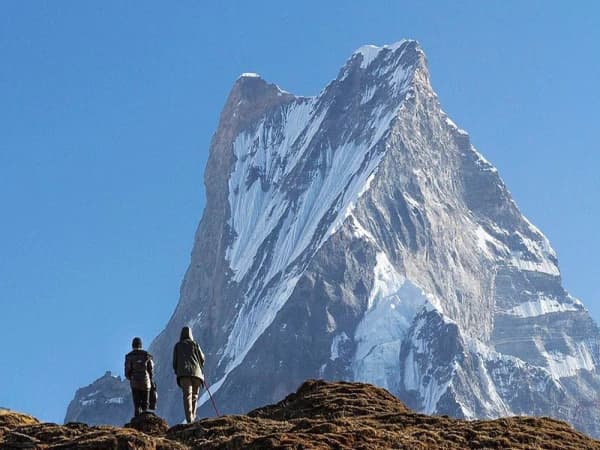


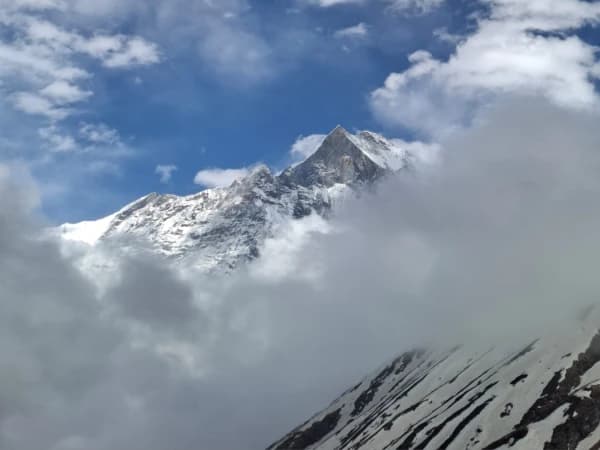
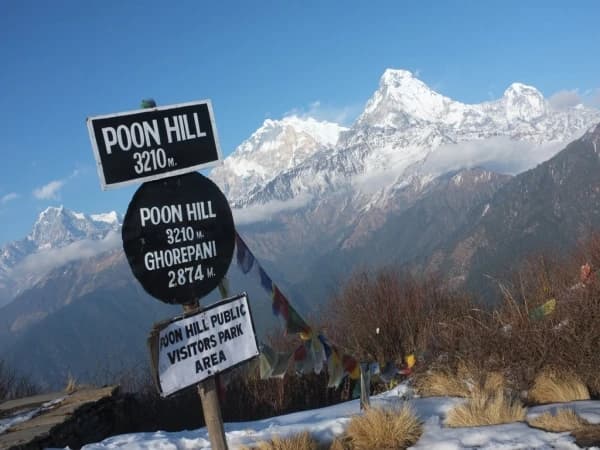
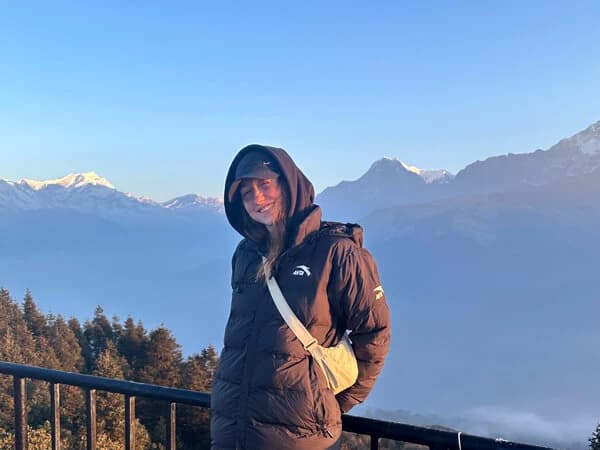
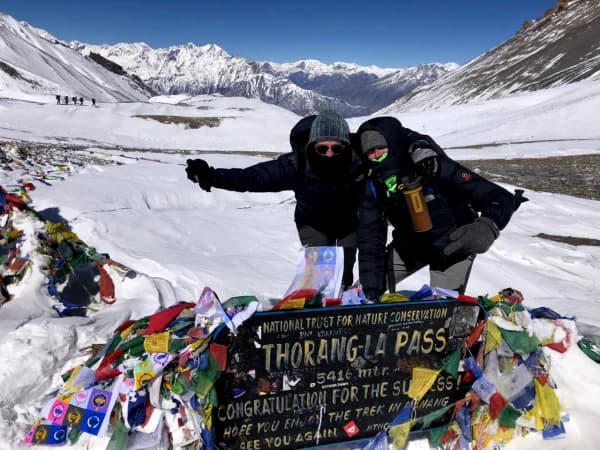
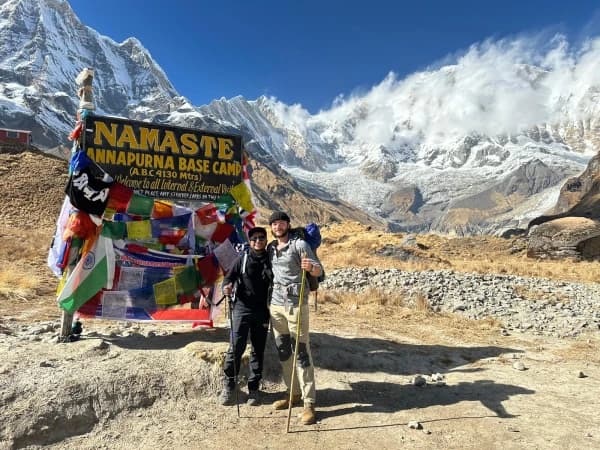
.webp&w=1200&q=75&dpl=dpl_7eaF3yFPztXTt494uMtv1ySrmMZT)
